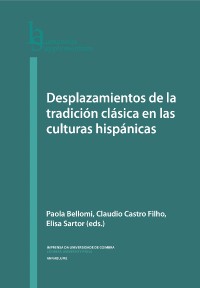Please use this identifier to cite or link to this item:
https://hdl.handle.net/10316.2/44005| DC Field | Value | Language |
|---|---|---|
| dc.contributor.author | Bracco, Diane | |
| dc.date.accessioned | 2018-06-28T12:47:13Z | |
| dc.date.accessioned | 2020-09-07T11:34:53Z | - |
| dc.date.available | 2018-06-28T12:47:13Z | |
| dc.date.available | 2020-09-07T11:34:53Z | - |
| dc.date.issued | 2018 | - |
| dc.identifier.isbn | 978-989-26-1549-3 | |
| dc.identifier.isbn | 978-989-26-1550-9 (PDF) | |
| dc.identifier.uri | https://hdl.handle.net/10316.2/44005 | - |
| dc.description.abstract | In 2001 Spanish director Bigas Lunas directed the drama Sound of the Sea (Son de mar), a cinematic transposition of the eponymous novel by the Valencian writer Manuel Vincent (1999). Using hypertextual variations around The Odyssey by Homer and The Aeneid by Virgil, the movie explores the theme of the journey, both in its geographical and conceptual dimensions. Through the dialogue that operates between the cinematographic text centered around the dialectic departure/return and the underlying epic references, we would like to explore the various ways in which “transfer” is explored in Sound of the Sea. From the initiatory odyssey of the protagonist, significantly named Ulysses, to the multiple comings and goings of the characters in the diegetic space, to the non-return journey of the spouses doomed to death, we will analyse the different occurrences of displacement whose literal expressions and metaphors contribute to forge a true poetics of roaming. The representations of movement and instability, associated with a maritime isotope, conflict with the images of stillness which are assimilated to the land’s immutability in a binary filmic tale in which the director restructures the mythical substratum. The recuperation of the epic materials implies not only their translation to another level of meaning but also a metamorphosis that implies a reinterpretation of the mobilised hypotexts to adapt them to a cinematographic and contemporary language. Thus, by updating those ancient sources, as well as by interweaving the visual and semantic networks, Bigas Luna gives expression to a sui generis mythology of the journey, deeply anchored in the Mediterranean environment of the Spanish Levante. | eng |
| dc.description.abstract | En 2001 el director español Bigas Luna dirige el drama Son de mar, transposición cinematográfica de la novela epónima del autor valenciano Manuel Vicent (1999). A través de unas variaciones hipertextuales sobre la Odisea de Homero y la Eneida de Virgilio, propone una reflexión sobre el motivo del viaje, entendido en una doble dimensión geográfica y conceptual. Este artículo se propone explorar las declinaciones del traslado a la luz del diálogo que se instaura entre el texto fílmico, vertebrado por la dialéctica salida/regreso, y los referentes épicos subyacentes. De la odisea iniciática del protagonista, significativamente llamado Ulises, al viaje sin retorno de los esposos condenados a la muerte, pasando por las múltiples idas y vueltas de los personajes por el espacio diegético, se analizarán las distintas ocurrencias del desplazamiento cuyas expresiones literales y metafóricas contribuyen a forjar una verdadera poética de la itinerancia. Las representaciones del movimiento y la inestabilidad, asociadas con la isotopía marítima, entran en conflicto con las imágenes de la inmovilidad, asimiladas con la inmutabilidad de la tierra, en un relato fílmico binario donde el director remodela el sustrato mítico: la recuperación de los materiales épicos supone no solo su traslación a otro circuito de significado sino también una metamorfosis que implica la reinterpretación de los hipotextos movilizados, en clave cinematográfica y contemporánea. Al actualizar dichas fuentes antiguas, al entrecruzar las redes visuales y semánticas, Bigas Luna plasma así una mitología del viaje sui generis, profundamente anclada en el ambiente mediterráneo del Levante español. | por |
| dc.language.iso | spa | - |
| dc.publisher | Imprensa da Universidade de Coimbra | por |
| dc.relation.ispartof | http://hdl.handle.net/10316.2/44002 | por |
| dc.rights | open access | - |
| dc.subject | Spanish cinema | eng |
| dc.subject | Bigas Luna | eng |
| dc.subject | poetics | eng |
| dc.subject | displacement | eng |
| dc.subject | journey | eng |
| dc.subject | cine español | por |
| dc.subject | Bigas Luna | por |
| dc.subject | poética | por |
| dc.subject | desplazamiento | por |
| dc.subject | viaje | por |
| dc.title | Feliz quien como Ulises ha hecho un largo viaje…: Son de mar o la poética cinematográfica del desplazamiento | por |
| dc.title.alternative | Whoever, as Ulysses, has been on a long journey is happy…: Sound of the Sea or the film poetics of displacement | eng |
| dc.type | bookPart | por |
| uc.publication.firstPage | 51 | - |
| uc.publication.lastPage | 68 | - |
| uc.publication.location | Coimbra | por |
| dc.identifier.doi | 10.14195/978-989-26-1550-9_3 | - |
| uc.publication.section | I - Poéticas del desplazamiento: subjetividad, odiseas y exilios | por |
| uc.publication.digCollection | PB | por |
| uc.publication.orderno | 3 | - |
| uc.publication.area | Artes e Humanidades | por |
| uc.publication.bookTitle | Desplazamientos de la tradición clásica en las culturas hispánicas | - |
| uc.publication.manifest | https://dl.uc.pt/json/iiif/10316.2/44005/204553/manifest?manifest=/json/iiif/10316.2/44005/204553/manifest | - |
| uc.publication.thumbnail | https://dl.uc.pt/retrieve/11062936 | - |
| uc.publication.parentItemId | 55049 | - |
| uc.itemId | 68924 | - |
| item.grantfulltext | open | - |
| item.fulltext | With Fulltext | - |
| Appears in Collections: | Desplazamientos de la tradición clásica en las culturas hispánicas | |
Files in This Item:
| File | Description | Size | Format | |
|---|---|---|---|---|
| feliz_quien_como_ulises.pdf | 1.13 MB | Adobe PDF |  |
Items in DSpace are protected by copyright, with all rights reserved, unless otherwise indicated.
